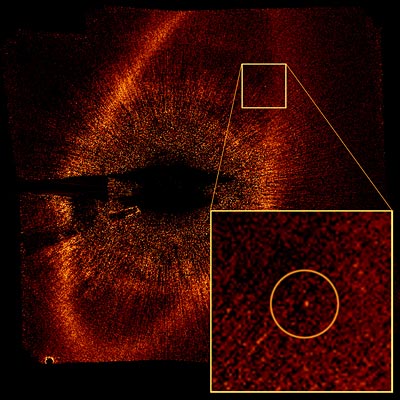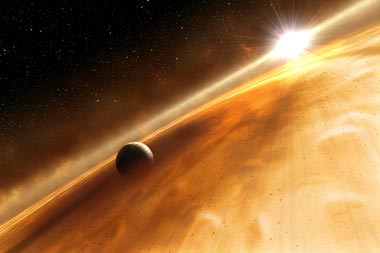Hubble snaps first optical photo of exoplanet
| 13 November 2008
BERKELEY — After eight years and repeated photographs of a nearby star in hopes of finding planets, University of California, Berkeley, astronomer Paul Kalas finally has his prize: the first visible-light snapshots of a planet outside our solar system.
 This 2006 Hubble Space Telescope optical image shows the belt of dust and debris (bright oval) surrounding the star Fomalhaut and the planet (inset) that orbits the star every 872 years and sculpts the inner edge of the belt. A coronagraph (center) on the Advanced Camera for Surveys blocks out the light of the star, which is 100 million times brighter than the planet. (Paul Kalas/UC Berkeley, NASA, ESA)
This 2006 Hubble Space Telescope optical image shows the belt of dust and debris (bright oval) surrounding the star Fomalhaut and the planet (inset) that orbits the star every 872 years and sculpts the inner edge of the belt. A coronagraph (center) on the Advanced Camera for Surveys blocks out the light of the star, which is 100 million times brighter than the planet. (Paul Kalas/UC Berkeley, NASA, ESA)The planet's existence was suspected in 2005, when images Kalas took with the Hubble Space Telescope's Advanced Camera for Surveys showed a sharply defined inner edge to the dust belt around Fomalhaut, in the southern constellation Piscus Austrinus (southern fish). The sharp edge and off-center belt suggested to Kalas that a planet in an elliptical orbit around the star was shaping the inner edge of the belt, much like Saturn's moons groom the edges of its rings.
"The gravity of Fomalhaut b is the key reason that the vast dust belt surrounding Fomalhaut is cleanly sculpted into a ring and offset from the star," Kalas said. "We predicted this in 2005, and now we have the direct proof."
"It will be hard to argue that a Jupiter-mass object orbiting an A star like Fomalhaut is anything other than a planet," said coauthor James R. Graham, professor of astronomy at UC Berkeley. "That doesn't mean it's exactly what we expected when we went hunting for planets in this system."
The discovery will be reported Nov. 14 on Science Express, an online site that posts articles in advance of their print publication in the journal Science.
The Science paper is complemented by an article to appear in The Astrophysical Journal (ApJ) that analyzes the interaction between the planet and the dust belt surrounding Fomalhaut and cinches the estimation of the planet's mass.
"Every planet has a chaotic zone, which is basically a swath of space that encloses the planet's orbit and from which the planet ejects all particles," said Eugene Chiang, a UC Berkeley associate professor of astronomy and of earth and planetary science, and first author of the ApJ paper. "This zone increases with the mass of the planet, so, given the size of the chaotic zone around Fomalhaut b, we can estimate that its likely mass is in the vicinity of one Jupiter mass."
 A NASA illustration showing the newly discovered planet, Fomalhaut b, orbiting the star Fomalhaut. The brown and gold colors are a Saturn-like ring that astronomers say may encircle the planet. A vast disk of dust and debris surrounding Fomalhaut is shown in the background as the curving cloud-like feature that appears to intersect the 200-million-year-old star. The planet lies 1.8 billion miles inside the disk's inner edge. (ESA, NASA, and L. Calçada [ESO for STScI])
A NASA illustration showing the newly discovered planet, Fomalhaut b, orbiting the star Fomalhaut. The brown and gold colors are a Saturn-like ring that astronomers say may encircle the planet. A vast disk of dust and debris surrounding Fomalhaut is shown in the background as the curving cloud-like feature that appears to intersect the 200-million-year-old star. The planet lies 1.8 billion miles inside the disk's inner edge. (ESA, NASA, and L. Calçada [ESO for STScI])Kalas has focused on the star Fomalhaut since his days 15 years ago as a graduate student, when he used early optical CCD technology to look for dust surrounding Fomalhaut. In 1998, submillimeter-wavelength radio observations of the disk showed that cold dust was distributed in a ring around the central star, much like the ring of comets called the Kuiper Belt in our solar system.
In 2004, Kalas began using Hubble's Advanced Camera for Surveys to probe the dust belt and, three years ago, he showed that the disk's inner edge was sharply delineated, suggesting that an unseen planet orbits Fomalhaut and shapes the edge.
He now has two photographs of the planet, taken in 2004 and 2006, which show that its movement over a 21-month period exactly fits what would be expected from a planet orbiting Fomalhaut every 872 years at a distance of 119 astronomical units, or 11 billion miles. One astronomical unit (AU) is the average distance between the Earth and the sun, or 93 million miles.
"I nearly had a heart attack at the end of May when I confirmed that Fomalhaut b orbits its parent star," Kalas said. "It's a profound and overwhelming experience to lay eyes on a planet never before seen."
Because of the relatively low mass and distant orbit of the planet, it cannot be detected by today's standard technique, which is to measure the tiny wobble a planet induces in its star. Astronomers hoping to photograph extrasolar planets have taken a different approach, looking in the infrared at young stars in hopes of detecting the warm glow from cooling planets. Fomalhaut b is not seen in the infrared, however. Instead, Kalas snapped photos in visible light, which for most planets would be impossible because of the bright glare of the star. Even with Hubble's coronagraph to block the star's light, the new planet would not have been detected if it had been much closer to its star, or much dimmer.
"To make this discovery at optical wavelengths is a complete surprise," he said. "If we're seeing light in reflection, then it must be because Fomalhaut b is surrounded by a planetary ring system so vast it would make Saturn's rings look pocket-sized by comparison. Fomalhaut b may actually show us what Jupiter and Saturn resembled when the solar system was about a hundred million years old."
Kalas noted that all other reported images of extrasolar planets have either been disproven or the planets have masses so uncertain they could be brown dwarfs, which are failed stars with masses above 13 Jupiter masses and that glow bright in the infrared. The Fomalhaut science team, on the other hand, used not only the observed brightness of Fomalhaut b to estimate the mass, but also the fact that a massive planet or brown dwarf would push Fomalhaut's dust belt farther away than what is observed. Chiang thinks he can narrow the mass to between 0.3 and 2 Jupiter masses, most likely one Jupiter mass.
"Any more massive than that and its gravity would destroy the vast dust belt encircling the star," Kalas said.
The belt extends from 133 to about 200 AU from the star, and Chiang estimates that, in dust alone, it has a mass that exceeds three Earths.
"There's so much solid material in the belt that it could easily form the basis of a core for a Jupiter-mass planet. This is consistent with Fomalhaut b having formed in situ, at an unprecedentedly large distance from its host star," Chiang said.
Fomalhaut is about 200 million years old and will burn out in about a billion years, making it a short-lived star compared to our sun, which is now about 4.5 billion years old and expected to burn another 5 billion years.
Its short life is a result of being 16 times brighter than the sun, but this also makes the star appear from the planet's surface about as bright as our sun appears from Neptune, despite the fact that it lies four times farther from Fomalhaut than Neptune does from the sun, Kalas said. "Fomalhaut b sits in a frigid location, but it's not too different from that of Neptune in our solar system," he said.
Interestingly, the planet mysteriously dimmed by half a stellar magnitude between the 2004 and 2006 observations. Fomalhaut b could have a hot outer atmosphere heated by bubbling convection cells, or the brightness change could indicate there is hot gas at the inner boundary of the ring around the planet.
"This is not your theorist's ideal planet, it is obviously more complicated than we thought," Graham said.
The researchers are awaiting repair of Hubble's Advanced Camera for Surveys and the Near Infrared Camera to resume their observations to confirm the planet's orbit, discover the source of its unusual brightness in the visible, and perhaps find other planets.
"There is plenty of empty space between Fomalhaut b and the star for other planets to happily reside in stable orbits," Kalas said. "We'll probably have to wait for the James Webb Space Telescope to give us a clear view of the region closer to the star where a planet could host liquid water on the surface."
The research was supported by National Aeronautics and Space Administration and the National Science Foundation.

